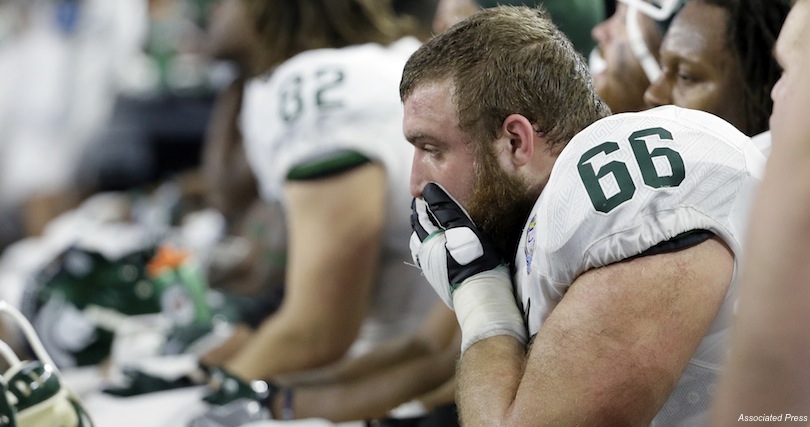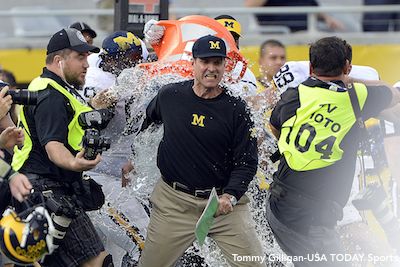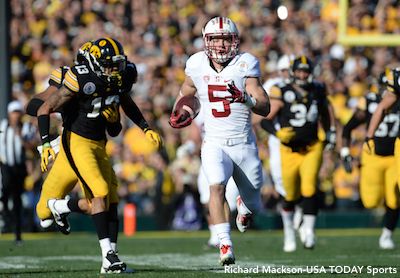The last two games almost saved the 2015-16 bowl season. We had TCU's amazing comeback from 31-0 down with a backup quarterback against Oregon. And then West Virginia and Arizona State dueled deep into the desert night in a game decided weirdly on a coach's brain fart.
But even those two games couldn't prevent the most lopsided bowl season in history. The record 40 bowl games were decided by an average of 15.9 points per game, breaking the previous mark of 15.3 set in 2012. Boise State's 55-7 romp over Northern Illinois in the Poinsettia Bowl was the most one-sided affair, but it was far from the only one.
The bad matchups were especially egregious during the two-day New Year's Day and New Year's Eve period, when the most high profile bowls (including all of the "New Year's Six") were played. None of the NY6 games were decided by fewer than two touchdowns, and the eight games over those two days had an average margin of 27.25 points.
Because the oversaturation of bowl games tend to produce mismatches, it's best not to read too much into the results. But since we do have a ton of data, we'll share what we've found:
What's your motivation?
There are always a few interim or lame duck coaches in bowl games because the job shuffling typically starts as soon (sometimes before) the regular season ends. And as usual it's difficult to predict which teams would play hard for the short-timer and which would not.
This year was no different. The eight teams helmed by an interim or departing/retiring coaches went 4-4. Six teams had assistants on the former staff coaching the bowl games and two had outgoing coaches in their swan song (BYU with Bronco Mendenhall headed to Virginia; Virginia Tech with retiring Frank Beamer). They split right down the middle.
Losers go out winners
For the first time, 5-7 teams were invited to bowl games because there weren't enough 6-6 or better teams to fill up the unprecedented 80 slots. Nebraska, Minnesota and San Jose State all received invitations to bowls based on superior Academic Progress Rate (APR) despite losing regular seasons.
And they all won, going 3-0 to all finish 6-7 on the season. San Jose State's win over Georgia State in the Cure Bowl produced for the first time losing records for both teams participating in a bowl game.
Don't be a bridesmaid

The worst performing group of teams this bowl season was the ones losing in their respective conference title games. Seems like the hangover all carried over to the bowl games, as these teams went 0-8.
And they didn't just lose, as nearly all of them lost big. Other than USC's 23-21 loss to Wisconsin on a late field goal in the Holiday Bowl, the other seven conference title game losers dropped their bowl games by an average of more than 24 points per game.
The winners of conference title games fared much better, going 6-2, with only Michigan State (in a playoff semifinal to another conference-title game winner) and Bowling Green (without a head coach) losing their bowl games.
Group of 5 supremacy
The American Athletic Conference puffed its chest after its champion Houston was picked for a New Year's Six bowl game and then dusted Florida State. But the rest of the conference didn't keep up its end of the bargain.
The AAC went 2-6 in bowl games, the worst record among all conferences. Besides Houston, only Navy won. Ironically the conference posted a 2-1 record against Power 5 teams but went 0-5 against other Group of 5 teams.
The rest of the G5 conferences all had middling results: Conference USA (3-2), Mountain West (4-4), Sun Belt (2-2) and MAC (3-4).
So just who won the bowl season?
S-E-C! S-E-C! S-E-C!
A year after a disastrous bowl season in which the SEC West teams went 2-5, with Alabama losing in the semifinals as the top seed, the purported toughest conference/division in college football came back with a vengeance. Alabama advanced to the title game and the vaunted SEC West went 6-1, with only Texas A&M losing.
As a whole, the SEC went 8-2, by far the best mark posted by any conference. Among Power 5 conferences, the Pac-12 came in a distant second at 6-4, followed by the Big Ten (5-5), ACC (4-5) and Big 12 (3-4).

The SEC's dominance does come with a couple of caveats. While it won its eight games by an average of nearly 26 points per game, SEC teams were favored in each of these games. And of those eight wins, only three were against ranked opponents -- the Big Ten won as many games against ranked teams as the SEC did.
The Big Ten, meanwhile, seems to have quality but not quantity at the top. A year after Ohio State won the national championship, there are signs that the conference might be slipping back into the Big Two and the others (just like the old days). The Buckeyes and their arch rival Michigan once again look like the class of the Big Ten, with Jim Harbaugh poised to haul in the No. 1-ranked recruiting class in 2016.
The rest of the conference will have a lot of catching up to do, including this season's title-game combatants Michigan State and Iowa, which both got annihilated in their respective bowl games.
-- Samuel Chi is the managing editor of RealClearSports.com and proprietor of College Football Exchange. Follow him on Twitter at @ThePlayoffGuru.






